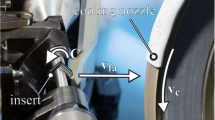Abstract
In this study, the influences caused by the wear of grinding wheel are investigated experimentally. The infrared radiation pyrometer with an optical fiber is developed and applied for the temperature measurement in the surface grinding process of carbon steels. Experimental data such as the temperature, the number and the size of effective cutting grains and the grinding forces are obtained over the wheel life, and they are used for the calculation of the thermal energy fraction to the workpiece, the grinding wheel and the chips. Thermal damage begins to be caused on the ground surface, as the attrition wear of grains decreases the number of effective cutting grains and degrades the efficiency of grinding wheel. The measuring of radiation pulses from the cutting grains makes it possible to detect the degradation of grinding wheel at an early stage of wheel life and prevent the severe damages on work surface.
Similar content being viewed by others
Abbreviations
- a :
-
wheel depth of cut
- a t :
-
actual depth of cut
- b w :
-
width of workpiece
- C :
-
specific heat
- d :
-
core diameter of optical fiber
- d g :
-
size of cutting edge
- D :
-
diameter of grinding wheel
- F n :
-
normal grinding force
- F t :
-
tangential grinding force
- k :
-
thermal conductivity
- K :
-
thermal diffusivity (= k/ρC)
- l :
-
half of grinding-zone length
- L :
-
dimensionless value of l
- n :
-
number of cutting grain per unit length
- q :
-
heat flux per area
- Q :
-
heat generated per unit time
- t :
-
measuring distance of pyrometer
- T :
-
temperature
- ν :
-
speed
- V :
-
removal volume of work material
- β:
-
thermal speed partition coefficient
- ρ:
-
density
- c:
-
chips
- g:
-
grinding wheel
- w:
-
workpiece
References
Singh, G. K., Yadava, V. and Kumar, R., “Diamond Face Grinding of WC-Co Composite with Spark Assistance: Experimental Study and Parameter Optimization,” Int. J. Precis. Eng. Manuf., Vol. 11, No. 4, pp. 509–518, 2010.
Wei, J., Zhang, Q., Xu, Z. and Lyu, S. K., “Study on Precision Grinding of Screw Rotors using CBN Wheel,” Int. J. Precis. Eng. Manuf., Vol. 11, No. 5, pp. 651–658, 2010.
Pahlitzsch, G. and Ernst, H., “Untersuchen uber das Verschleiss-verhalten von Schleifscheiben,” Industrie Anzeiger, Vol. 79, No. 80, pp. 1193–1199, 1957.
Nakayama, K. and Shaw, M. C., “Roughness of Ground Surface,” Trans. of the Japan Society of Mechanical Engineers, Vol. 37, No. 293, pp. 178–186, 1971.
Tamai, Y. and Kawamura, S., “Height Distribution of Cutting Edges in the Grinding Process,” Journal of Japan Society of Precision Engineering, Vol. 36, No. 4, pp. 263–269, 1970.
Tsuwa, H., “An Investigation of Grinding Wheel Cutting Edges,” Trans. of the ASME, Journal of Engineering for Industry, Vol. 86, No. 4, pp. 371–382, 1964.
Tsuwa, H., “Evaluation of Grinding Wheel by Behavior of Cutting Edges,” Science of Machine, Vol. 13, No. 2, pp. 273–279, 1961.
Brinksmeier, E. and Werner, F., “Monitoring of Grinding Wheel Wear,” Annals of the CIRP, Vol. 41, No. 1, pp. 373–376, 1992.
Hosokawa, A. and Mashimo, K., “Evaluation of Grinding Wheel Surface by Means of Grinding Sound Discrimination,” JSME Journal Ser. C, Vol. 47, No. 1, pp. 52–58, 2004.
Rajmohan, B. and Radhakrishnan, V., “On the Possibility of Process Monitoring in Grinding by Spark Intensity Measurements, Trans. of the ASME,” Journal of Engineering for Industry, Vol. 116, No. 1, pp. 127–133, 1994.
Ueda, T., Hosokawa, A. and Yamamoto, A., “Studies on Temperature of Abrasive Grains in Grinding -Application of Infrared Radiation Pyrometer,” Trans. of the ASME, Journal of Engineering for Industry, Vol. 107, No. 2, pp. 127–133, 1985.
Snoeys, R. and Leuven, K. U., “Thermal Induced Damage in Grinding,” Annals of the CIRP, Vol. 27, No. 2, pp. 571–581, 1978.
Carslaw, H. S. and Jaeger, J. C., “Conduction of Heat in Solids 2nd edition,” Oxford Science Publication, p. 75, 1959.
Ueda, T. and Hosokawa, A., “Thermal Analysis of Active Grains in Surface Grinding,” Journal of Japan Society of Precision Engineering, Vol. 58, No. 2, pp. 1732–1737, 1985.
Kohli, S., Guo, C. and Malkin, S., “Energy Partition to the Workpiece for Grinding with Aluminum Oxide and CBN Abrasive Wheel,” Trans. of the ASME, Journal of Engineering for Industry, Vol. 117, No. 2, pp.160–168, 1995.
Guo, C., Wu, Y., Varghese, V. and Malkin, S., “Temperature and Energy Partition for Grinding with Vitrified CBN Wheel,” Annals of the CIRP, Vol. 48, No. 1, pp. 247–250, 1999.
Upadhyaya, R. P. and Malkin, S., “Thermal Aspects of Grinding with Electroplated CBN Wheel,” Trans. of the ASME, Journal of Manufacturing Science and Engineering, Vol. 126, No. 1, pp. 107–114, 2004.
Ueda, T. and Yamada, K., “Measurement of Grinding Temperature of Ceramics Using Infrared Radiation Pyrometer with Optical Fiber,” Trans. of the ASME, Journal of Engineering for Industry, Vol. 114, No. 3, pp. 317–322, 1992.
Malkin, S. and Anderson, R. B., “Thermal Aspects of Grinding, Part 1 — Energy Partition,” Trans. of the ASME, Journal of Engineering for Industry, Vol. 96, No. 4, pp. 1177–1183, 1974.
Author information
Authors and Affiliations
Corresponding author
Rights and permissions
About this article
Cite this article
Yamada, K., Ueda, T. & Hosokawa, A. A study on aspects of attrition wear of cutting grains in grinding process. Int. J. Precis. Eng. Manuf. 12, 965–973 (2011). https://doi.org/10.1007/s12541-011-0129-1
Received:
Accepted:
Published:
Issue Date:
DOI: https://doi.org/10.1007/s12541-011-0129-1



